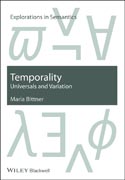
Temporality surveys the ways in which languages of different types refer to past, present, and future events, through an in–depth examination of four major language types: tense–based English, tense–aspect–based Polish, aspect–based Chinese, and mood–based Kalaallisut. Cutting–edge research on directly compositional dynamic semantics of languages with and without grammatical tense New in–depth analysis of temporal, aspectual, modal, as well as nominal discourse reference Presents a novel logical language for representing linguistic meaning (Update with Centering) Develops a unified theory of tense, aspect, mood, and person as different types of ‘grammatical centering systems’ INDICE: Figures Glosses Acknowledgments Introduction Part I Semantic universals Chapter 1 Direct semantic composition 1.1 Simple Type Logic (TL0) 1.2 A CG.TL0 fragment of English 1.3 Dynamic Type Logic (DL0) 1.4 A CG.DL0 fragment of English 1.5 Centering: A blind spot of English–based logics Chapter 2 Nominal reference with centering 2.1 Center v. periphery: Anaphora to structured lists 2.2 Kalaallisut third person inflections as top–level anaphora 2.3 Mandarin third person features as top–level anaphora 2.4 English third person pronouns as shallow anaphora 2.5 Simple Update with Centering (UC0) Chapter 3 Tense as temporal centering 3.1 Polish third person inflections as top–level anaphora 3.2 Polish tenses as top–level temporal reference 3.3 English tenses as temporal (in)definites 3.4 English tenses as top–level temporal reference 3.5 UC0 with temporal centering (UCτ) Chapter 4 Aspect as eventuality centering 4.1 Polish aspect features v. inflections 4.2 Mandarin aspect features v. particles 4.3 English aspectual auxiliaries 4.4 UCτ with mereology (UCτ+) Chapter 5 Quantification as reference to sets 5.1 Nominal quantification and anaphora 5.2 Nominal quantification and temporal reference 5.3 Temporal quantification and anaphora 5.4 UCτ+ with discourse referents for sets (UCτ||) Chapter 6 Mood as illocutionary centering 6.1 Illocutionary moods with(out) reportative recentering 6.2 (Not–)at–issue content as modal discourse reference 6.3 (Not–)at–issue with start–up illocutionary referents 6.4 Dependent moods as perspectival (re)centering 6.5 UCδ|| with illocutionary referents (UCεω||) Chapter 7 (In)direct speech and attitude reports 7.1 Mood with(out) reportative recentering revisited 7.2 At–issue reports with finite complements 7.3 At–issue reports with non–finite complements 7.4 UC: Combining UCτ|| and UCεω|| Part II Temporal variation Chapter 8 Tense–based temporality in English 8.1 Indexical past with(out) recentering aspect 8.2 Indexical non–past with(out) recentering aspect 8.3 Reports: Speaker’s view of subject’s (non–)past 8.4 Quantification: Tenses in distributive contexts 8.5 A CG.UC fragment of English Chapter 9 Tense–aspect–based temporality in Polish 9.1 Relative past (im)perfective 9.2 Relative non–past (im)perfective 9.3 Reports: Subject’s (non–)past 9.4 Quantification: Distributed (im)perfectives 9.5 A CG.UC fragment of Polish Chapter 10 Aspect–based temporality in Mandarin 10.1 Non–future: Verifiable Topic State 10.2 Future: Prospective Topic State or comment 10.3 Reports: Attitudinal Topic State or comment 10.4 Quantification: Topical habit or distributive comment 10.5 A CG.UC fragment of Mandarin Chapter 11 Mood–based temporality in Kalaallisut 11.1 Non–future: Verfiable eventualities 11.2 Future: Verifiable eventualities with future c–points 11.3 Reports: Verifiability from agent?s perspective 11.4 Quantification: Verifiable habits 11.5 A CG.UC fragment of Kalaallisut Conclusion Bibliography Author index Subject index
- ISBN: 978-1-4051-9039-8
- Editorial: Wiley–Blackwell
- Encuadernacion: Rústica
- Páginas: 312
- Fecha Publicación: 09/05/2014
- Nº Volúmenes: 1
- Idioma: Inglés
